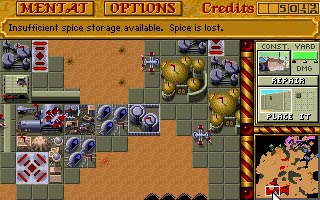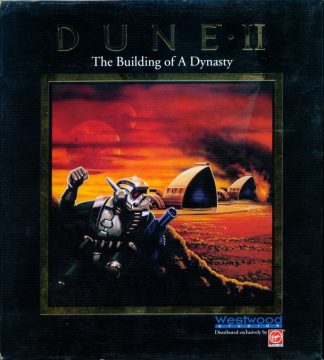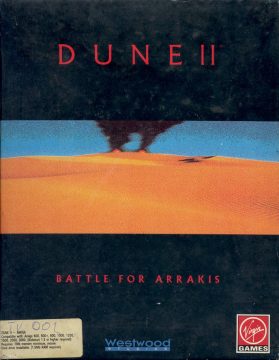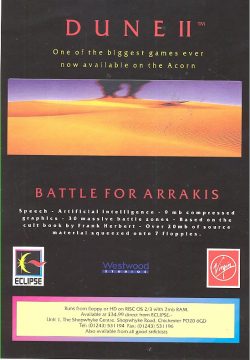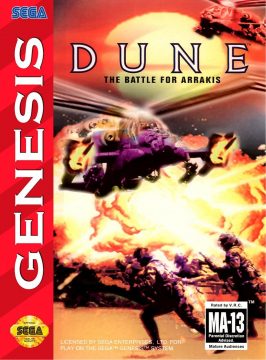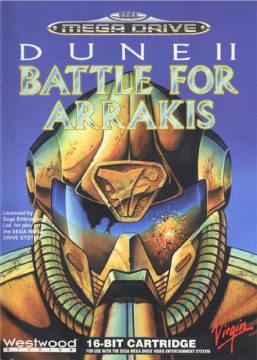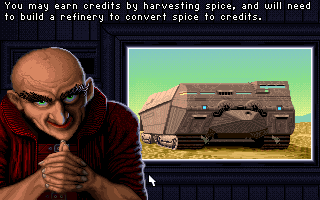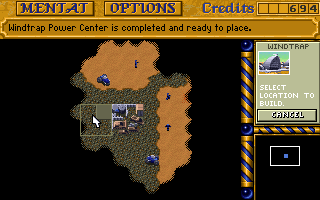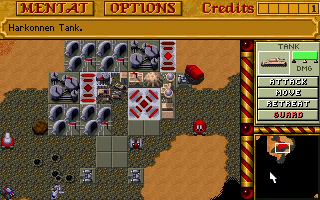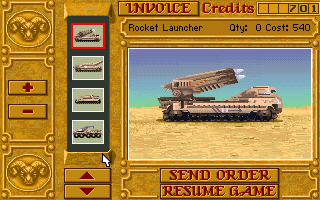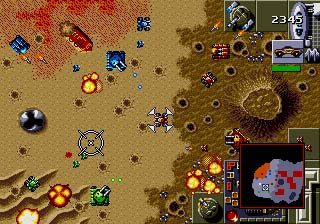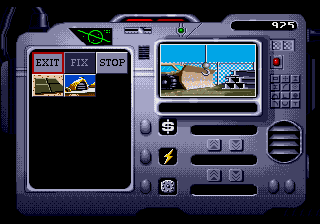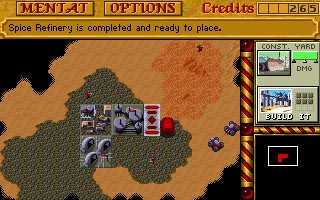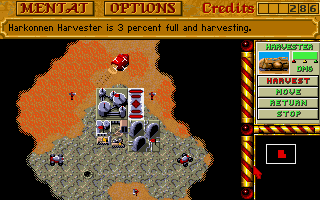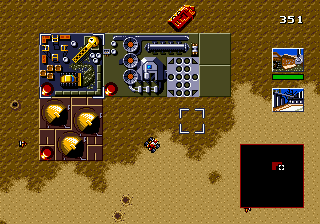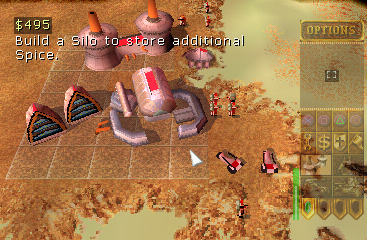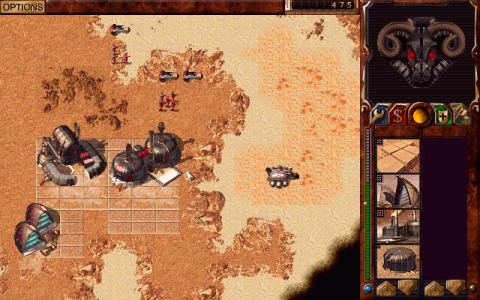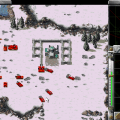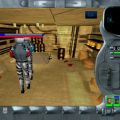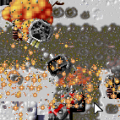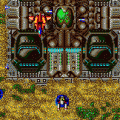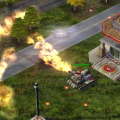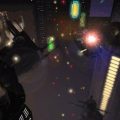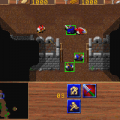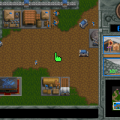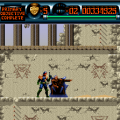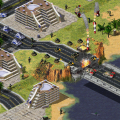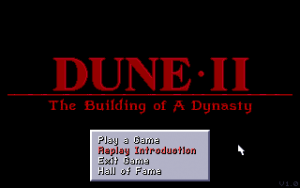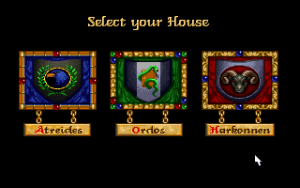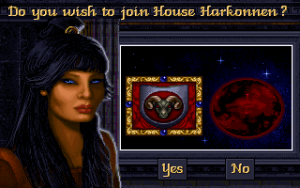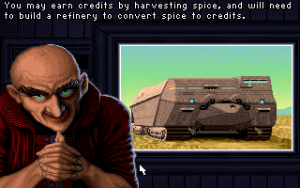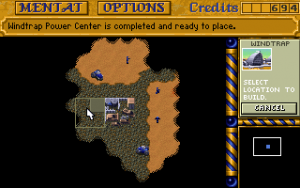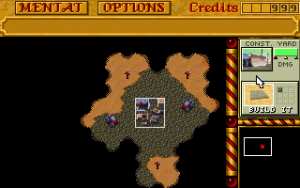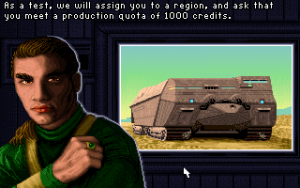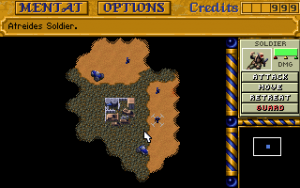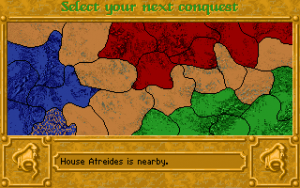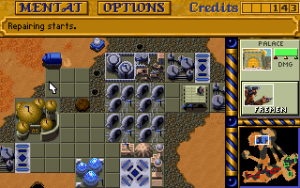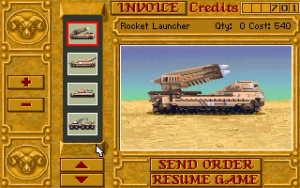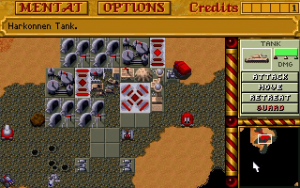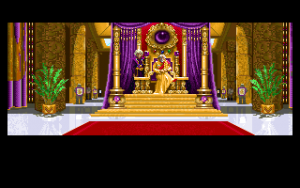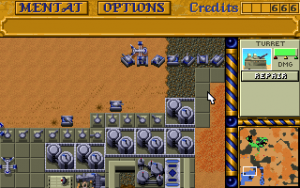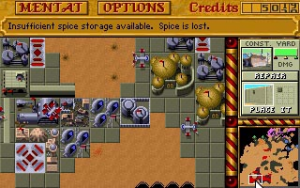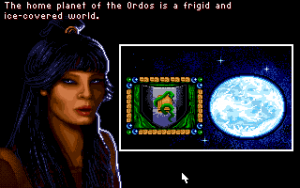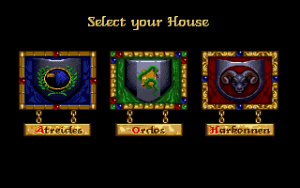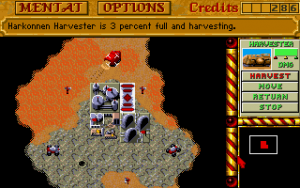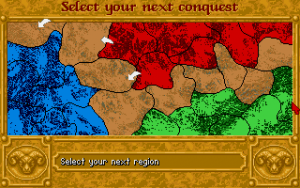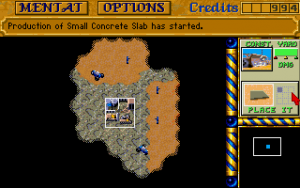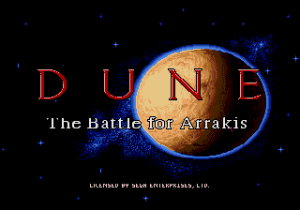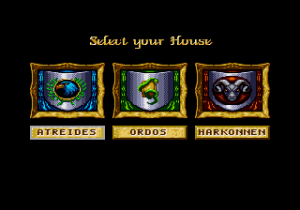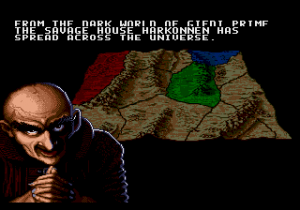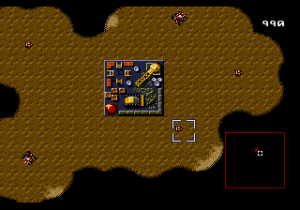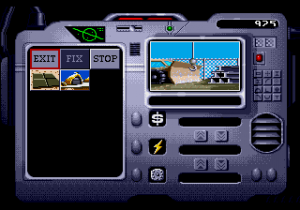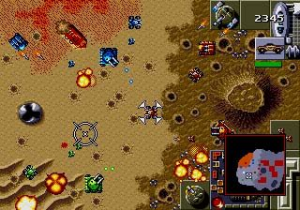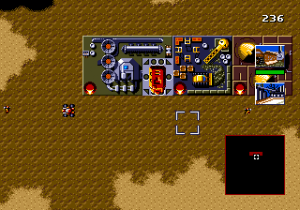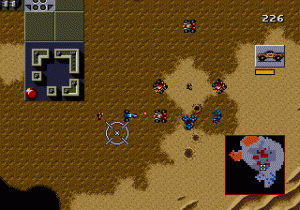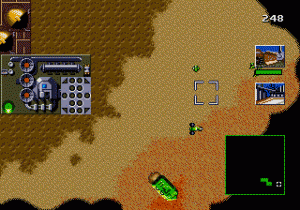- Dune
- Dune II: The Building of a Dynasty
- Dune 2000
- Emperor: Battle for Dune
- Behind the Dune
While Cryo Interactive Entertainment was already busy developing Dune, Virgin Interactive tasked Westwood Studios with the development of their own Dune-licensed game. The end result would be Dune II: The Building of a Dynasty, published as Dune II: Battle for Arrakis in Europe. Dune II: The Building of a Dynasty would be the foundation of many a later real-time strategy game, including Westwood’s own Command & Conquer series. Real-time strategy already existed in several forms when Westwood started their development on the game, most notably with titles such as The Ancient Art of War or Herzog Zwei. However, none of these games featured the defining trinity of base building, resource gathering, and army management. Interestingly enough, Westwood apparently took as much inspiration from their own Eye of the Beholder as they did from Herzog Zwei. While a dungeon crawler and not a strategy game, Eye of the Beholder does run in real time. Additionally, Populous is cited as an inspiration for the developers alongside the turn-based titles Military Madness and Civilization.
Less inspiration was taken from the actual Dune source material. The basics are kept intact; Spice is still the most valuable substance in the universe, and noble houses are still fighting over it. New are tanks, rocket launchers, and all kinds of military hardware that was never mentioned anywhere in the books. The Emperor is a different one too; instead of Shaddam IV, Dune II: The Building of a Dynasty introduces Frederick IV. Desperate for money and fearing for his power, the Emperor permits three of the Great Houses to fight over Arrakis. Whichever house delivers him the highest amount of Spice shall receive Arrakis as a fief. In the race are the noble Atreides and the evil Harkonnen as well as a new house, House Ordos. The insidious Ordos are not mentioned in the mainline Dune novels, but are listed in the semi-canonical Dune Encyclopedia. House Corrino, the Emperor’s house, appears as a non-playable faction.
Dune II: The Building of a Dynasty offers no multiplayer or skirmish mode. Instead, the player has the choice between three campaigns consisting of nine mission each. Follow-up missions can be selected on the campaign map, which indicates the progress of each noble house. However, the plot remains the same no matter what choices the player makes; picking a different mission merely leads to an alternative map with a different layout and balance of enemy forces. The first few missions aside, the goal is always the destruction of all enemy bases. Initially, all three houses make gains, but halfway through the campaign, a cutscene reveals that the supposedly neutral Emperor was secretly supporting one of the enemy factions. Even later, both enemy factions ally against the now-dominant player house. This culminates in the final mission, where both enemy houses and the Emperor’s troops attempt to wipe the player’s house off the map. This plots (with flipped colors) is the same for every house, even though the ending differs slightly. The Atreides force the Emperor to abdicate, the Harkonnen blow him to pieces with a rocket launcher, and the Ordos, a cartel of wealthy merchants, turn him into their puppet. Or have him eaten by some giant space lizard; it is not entirely clear.
However, the core of Dune II: The Building of a Dynasty is not the plot, it is the gameplay. Each missions starts the player with a construction yard or a mobile construction vehicle that can be turned into one. Once deployed, it gives the player access to other structures. Building is only possible on rocky terrain, not on the ubiquitous sand. Placing concrete slabs under a building is optional, but recommended; a building without such a foundation starts at half health and will be damaged over time even if repaired to full health. Wind traps provide power. A lack of electricity slows the production of all buildings and units, and once more damages buildings over time. Troops are produced in the barracks, trooper training facility, light and heavy factories, and high-tech factory. Other buildings include a repair facility, a starport from which units can be purchased, two types or defensive turrets, and outpost that gives the player access to the minimap and the Ix research center. Additionally, there is the Spice refinery and the Spice silo. The former comes with a harvester that harvests Spice on the map. Spice is the only harvestable resource servers as the currency in Dune II: The Building of a Dynasty. The silo can store additional Spice, but is mostly superfluous: Spice should be spent, never stored. The highest-tier structure is the palace, which grants each house access to their special weapon. These buildings are shared across all factions.
Partially shared are Dune II: The Building of a Dynasty‘s units. Every house has access to basic infantry. Infantry is virtually useless; they are slow, weak, and can be crushed by vehicles. Their only real purpose is reconnaissance, though infantry does have one special ability: sending an infantry unit into a building damages it, unless the building’s health bar is in the red. In this case, the building is captured and the player might gain access to new technologies. However, not all buildings can be captured, the AI always repairs buildings, which makes it difficult to send in the occupier at the right time, and getting infantry to the enemy base in one piece as a challenge all by itself. Spice spent on infantry is, for the most part, wasted Spice. Marginally more useful are rocket troopers, efficient against vehicles, and the Emperor’s elite Sardaukar troops.
Of more use than brittle footmen are the vehicles from the light factory. The trike and the quad are more durable and significantly faster, but stand no chance against the vehicles from the heavy factory. The heavy factory produces the combat tank, which is somewhat useful against everything as well as the siege tank, which excels against infantry and buildings. The true killer, however, is the missile tank. While lightly armored, imprecise, and slow, the missile tank deals a tremendous amount of damage. A small group of missile tanks raises any structure in no time, provided they hit it. Additionally, the missile tank outranges most other weapons and can target air units. Air support is provided by carryall, a transport for Spice harvesters and damaged units, and the ornithopter bomber. Unfortunately, the latter cannot be controlled and starts its bombing runs right after it leaves the factory, making it difficult to use effectively.
In addition to the basic roster of units, each house has access to special hardware. Once a palace has been build, the Atreides can summon Fremen natives to their aid. The Fremen semi-randomly appear at the edge of the map and can flank an unsuspecting enemy. Additionally, the Atreides can build sonic tanks – no doubt inspired by David Lynch’s Dune, just like the weirding modules from Dune. Sonic tanks are not heavily armored, but have great range and damage everything in their line of fire. They are also in tune with the Atreides theme of being the high-tech faction. Curiously, their rate of fire is tried to the frame rate the game runs at, giving players with (then) powerful hardware an edge.
The sneaky Ordos, on the other hand, replace the standard trike with the raider trike. The raider trike is even lighter than the regular version, but also faster and more maneuverable. The Ordos palace unit is the deviator. The Deviator launchers gas-filled missiles that have a certain chance to brainwash enemy units. However, this rarely works, and even if it does, the effect does not last long. This is a different story when the AI does it, who flat-out cheats and has a higher chance to mind-control units. Additionally, the Ordos do not have access to the regular missile launcher, leaving them with no long-ranged unit that is actually any good. With a palace, the Ordos can summon a saboteur. This suicide unit is very fast and destroys every unit or building it enters – even sandworms. However, the saboteur has little health and armor, and is difficult to utilize properly.
The brutish Harkonnen do away with the lightest of light units and instead roll in the Devastator. The dual-cannoned Devastator is the heaviest tank in Dune II: The Building of a Dynasty and in fact so heavy that it requires a nuclear engine to run. This makes the Devastator a bit of a liability; should it be destroyed, it explodes and damages all units and buildings around it. Devastators can also be detonated on purpose. This is especially useful when an Ordos player temporarily takes over an enemy Devastator. Even more radioactive is the Harkonnen Death Hand missile, a nuclear cluster missile launched from the palace. While ridiculously imprecise, the Death Hand can destroy any building it hits, even an enemy construction yard.
Despite a great variety of units and thematically fitting tech for each house, Dune II: The Building of a Dynasty discourages the use of a mixed army. The archaic interface – all units have to be commanded separately – encourages the player to use a small but powerful task force, which almost always boils down to using missile tanks with support. This is even true for House Ordos, which cannot even build them, as they can still purchase missile tanks from the starport. Equally archaic is the rest of the interface. Building anything brings up an entirely new screen. The low resolution allows the player to only see a faction of the battlefield. Furthermore, the AI cheats like crazy. It does not activate the vehicle-eating sandworms that haunt the entire planet, though player units do. If an AI building or unit is destroyed, the AI receives their money back. The AI can also see through the shroud and rebuild structures anywhere, even on top of units.
That said, Dune II: The Building of a Dynasty was treading new ground. The way this game executes real-time strategy had not been seen before and would be the basis for countless games to come, including its sequel-remake, Dune 2000, and its respective sequel, Emperor: Battle for Dune. Nevertheless, it is fondly remembered and inspired a number of unofficial remakes and mods, among them Dune II: The Maker, Dune Dynasty, Dune Legacy, and Dune III. Developed originally for MS-DOS, the Amiga and Acorn 32-bit received their own version of Dune II: The Building of a Dynasty. There are slight changes to the music and much of the music (and sound) is gone, but otherwise, they are nearly identical to the MS-DOS version.
TheGenesis/Mega Drive release, Dune: The Battle for Arrakis, made more changes, even if the fundamentals stay the same. It’s sort of a midway point between the IBM PC version and Command and Conquer, in that it adds context sensitive controls and removes the status bar for a full screen view of the action. It’s a nicely suitable change for both changing to a television and using a controller. The visuals have been tweaked so some things are larger, especially the structures, though many units are about the same size. The building menus have been revamped with smaller icons so everything fits on a single screen, and has been redesigned to look like a radio transmitter, which is a nice touch. The music has been completely redone, though it’s much in the style of the IBM PC version, so the new tunes are welcome. There are only nine maps available per campaign, though, and passwords replace the save feature. The later missions become problematic, as the number of units create a significant amount of slowdown, plus without the ability to save mid-mission, the difficulty becomes much higher. So while this port is about the best as one could hope for it given the hardware, technical constraints still hold it back.
The main shortcoming of Dune II: The Building of a Dynasty is the pace at which it became dated. Released in 1994, Blizzard Entertainment’s WarCraft: Orcs & Humans offered significant improvements over Dune II: The Building of a Dynasty. A year after that, Westwood’s own Command & Conquer took the best elements of its sandy predecessor and improved it in every conceivable way. Thus, just years after it was the pioneer of a new genre, Dune II: The Building of a Dynasty became a victim of its own success – albeit a classic one.
